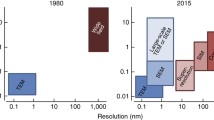Abstract
Bioimaging: the visualisation, localisation and tracking of movement of specific molecules in cells using microscopy has become an increasing field of interest within life science research. For this, the availability of fluorescent and electron-dense markers for light and electron microscopy, respectively, is an essential tool to attach to the molecules of interest. In recent years, there has been an increasing effort to combine light and electron microscopy in a single experiment. Such correlative light electron microscopy (CLEM) experiments thus rely on using markers that are both fluorescent and electron dense. Unfortunately, there are very few markers that possess both these properties. Markers for light microscopy such as green fluorescent protein are generally not directly visible in the electron microscopy and vice versa for gold particles. Hence, there has been an intensive search for markers that are directly visible both in the light microscope and in the electron microscope. Here we discuss some of the strategies and pitfalls that are associated with the use of CLEM markers, which might serve as a “warning” that new probes should be extensively tested before use. We focus on the use of CLEM markers for the study of intracellular transport and specifically endocytosis.





Similar content being viewed by others
Abbreviations
- GFP:
-
green fluorescent protein
- CLEM:
-
correlative light electron microscopy
- LM:
-
light microscopy
- EM:
-
electron microscopy
- EGF:
-
epidermal growth factor
- Tf:
-
Transferrin
- EGFR:
-
EGF receptor
- TfR:
-
Transferrin receptor
- DAB:
-
diaminobenzidine
- QD:
-
quantum dot
- TEM:
-
Transmission Electron Microscopy
- SAF:
-
self-assembling fibre
- MAPK:
-
Mitogen Activated Protein Kinase
References
Brown E, Mantell J, Carter D, Tilly G, Verkade P (2009) Studying intracellular transport using high-pressure freezing and correlative light electron microscopy. Semin Cell Dev Biol 20:910–919
Futter CE, Pearse A, Hewlett LJ, Hopkins CR (1996) Multivesicular endosomes containing internalized EGF–EGF receptor complexes mature and the fuse directly with lysosomes. J Cell Biol 132(6):1011–1023
Gaietta G, Deerinck TJ, Adams SR, Bouwer J, Tour O, Laird DW, Sosinsky GE, Tsien RY, Ellisman MH (2002) Multicolor and electron microscopic imaging of connexin trafficking. Science 296:503–507
Giepmans BN (2008) Bridging fluorescence microscopy and electron microscopy. Histochem Cell Biol 130:211–217
Giepmans BN, Deerinck TJ, Smarr BL, Jones YZ, Ellisman MH (2005) Correlated light and electron microscopic imaging of multiple endogenous proteins using Quantum dots. Nat Meth 2:743–749
Kandela IK, Meyer DA, Oshel PE, Rosa-Molinar E, Albrecht RM (2003) Fluorescence quenching by colloidal heavy metals: implications for correlative fluorescence and electron microscopy studies. Microsc Microanal 9:1194–1195
Mironov AA, Polishchuk RS, Luini A (2000) Visualizing membrane traffic in vivo by combined video fluorescence and 3D electron microscopy. Trends Cell Biol 10:349–453
Morris RE, Ciraolo GM, Saelinger CB (1992) Validation of the biotinyl ligand-avidin-gold technique. J Histochem Cytochem 40(5):711–721
Muller-Reichert T, Srayko M, Hyman A, O'Toole ET, McDonald K (2007) Correlative light and electron microscopy of early Caenorhabditis elegans embryos in mitosis. Meth Cell Biol 79:101–119
Neutra MR, Ciechanover A, Owen LS, Lodish HF (1985) Intracellular transport of transferrin- and asialoorosomucoid–colloidal gold conjugates to lysosomes after receptor-mediated endocytosis. J Histochem Cytochem 33(10):1134–1144
Plitzko JM, Rigort A, Leis A (2009) Correlative cryo-light microscopy and cryo-electron tomography: from cellular territories to molecular landscapes. Curr Opin Biotechnol 20:83–89
Polishchuk RS, Polishchuk EV, Marra P, Alberti S, Buccione R, Luini A, Mironov AA (2000) Correlative light-electron microscopy reveals the tubular–saccular ultrastructure of carriers operating between Golgi apparatus and plasma membrane. J Cell Biol 148:45–58
Robinson JM, Takizawa T (2009) Correlative fluorescence and electron microscopy in tissues: immunocytochemistry. J Microsc 235:259–272
Van Rijnsoever C, Oorschot V, Klumperman J (2008) Correlative light-electron microscopy (CLEM) combining live-cell imaging and immunolabeling of ultrathin cryosections. Nat Methods 5:973–980
Van Weering J, Brown E, Mantell J, Sharp T, Verkade P (2010) Studying membrane traffic in high resolution. Methods Cell Biol, in press
Verkade P (2008) Moving EM: the rapid transfer system as a new tool for correlative light and electron microscopy and high throughput for high-pressure freezing. J Microsc 230:317–328
Yarden Y (2001) The EGFR family and its ligands in human cancer: signalling mechanisms and therapeutic opportunities. Eur J Cancer 37:S3–S8
Conflict of interest
The authors declare that they have no conflict of interest.
Author information
Authors and Affiliations
Corresponding author
Additional information
Handling Editor: David Robinson
Electronic supplementary material
Below is the link to the electronic supplementary material.
(MOV 4021 kb)
Rights and permissions
About this article
Cite this article
Brown, E., Verkade, P. The use of markers for correlative light electron microscopy. Protoplasma 244, 91–97 (2010). https://doi.org/10.1007/s00709-010-0165-1
Received:
Accepted:
Published:
Issue Date:
DOI: https://doi.org/10.1007/s00709-010-0165-1




